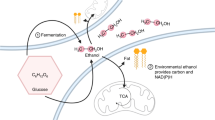Abstract
The hyperthermophilic anaerobe Pyrococcus furiosus was found to grow on pyruvate as energy and carbon source. Growth was dependent on yeast extract (0.1%). The organism grew with doublings times of about 1 h up to cell densities of 1–2×108 cells/ml. During growth 0.6–0.8 mol acetate and 1.2–1.5 mol CO2 and 0.8 mol H2 were formed per mol of pyruvate consumed. The molar growth yield was 10–11 g cells(dry weight)/mol pyruvate. Cell suspensions catalyzed the conversion of 1 mol of pyruvate to 0.6–0.8 mol acetate, 1.2–1.5 mol CO2, 1.2 mol H2 and 0.03 mol acetoin. After fermentation of [3-14C]pyruvate the specific radioactivities of pyruvate, CO2 and acetate were equal to 1:0.01:1. Cellfree extracts contained the following enzymatic activities: pyruvate: ferredoxin (methyl viologen) oxidoreductase (0.2 U mg-1, T=60°C, with Clostridium pasteurianum ferredoxin as electron acceptor; 1.4 U mg-1 at 90°C, with methyl viologen as electron acceptor); acetyl-CoA synthetase (ADP forming) [acetyl-CoA+ADP+Pi⇆acetate+ATP+CoA] (0.34 U mg-1, T=90°C), and hydrogen: methyl viologen oxidoreductase (1.75 U mg-1). Phosphate acetyl-transferase activity, acetate kinase activity, and carbon monoxide:methyl viologen oxidoreductase activity could not be detected. These findings indicate that the archaebacterium P. furiosus ferments pyruvate to acetate, CO2 and H2 involving only three enzymes, a pyruvate:ferredoxin oxidoreductase, a hydrogenase and an acetyl-CoA synthetase (ADP forming).
Similar content being viewed by others
Abbreviations
- DTE:
-
dithioerythritol
- MV:
-
methyl viologen
- MOPS:
-
morpholinopropane sulfonic acid
- Tricine:
-
N-tris(hydroxymethyl)-methylglycine
References
Adams MWW (1990) The metabolism of hydrogen by extreme thermophilic, sulfur dependent bacteria. FEMS Microbiol Rev 75: 219–238
Aono S, Bryant FO, Adams MWW (1989) A novel and remarkably thermostable ferredoxin from the hyperthermophilic archaebacterium Pyrococcus furiosus. J Bacteriol 171: 3433–3439
Blumentals II, Itoh M, Olson GJ, Kelly RM (1990) Role of polysulfides in reduction of elemental sulfur by the hyperthermophilic archaebacterium Pyrococcus furiosus. Appl Environ Microbiol 56: 1255–1262
Bode CH, Goebel H, Stähler E(1968) Zur Eliminierung von Trübungsfehlern bei der Eiweißbestimmung mit der Biuretmethode. Z Klin Chem Klin Biochem 5: 419–422
Brown SH, Kelly RM (1989) Cultivation techniques of the hyperthermophilic archaebacteria: continuous culture of Pyrococcus furiosus at temperatures near 100°C. Appl Environ Microbiol 55: 2086–2088
Bryant FO, Adams MWW (1989) Characterization of hydrogenase from the hyperthermophilic archaebacterium, Pyrococcus furiosus. J Biol Chem 264: 5070–5079
Danson MJ (1988) Archaebacteria: The comparative enzymology of their central metabolic pathways. Adv Microb Physiol 29: 165–231
Danson MJ (1989) Central metabolism of the archaebacteria: an overview. Can J Microbiol 35: 58–64
Decker K, Jungermann K, Thauer RK (1970) Energy production in anaerobic organisms. Angewandte Chemie (Int Edn) 9: 138–158
Dorn M, Andreesen JR, Gottschalk G (1978) Fermentation of fumarate and l-malate by Clostridium formicoaceticum. J Bacteriol 133: 26–32
Fiala G, Stetter KO (1986) Pyrococcus furiosus sp. nov. represents a novel genus of marine heterotrophic archaebacteria growing optimally at 100°C. Arch Microbiol 145: 56–61
Gottschalk G (1986) Bacterial metabolism, 2nd edn. Springer, Berlin Heidelberg New York
Kohler HPE, Zehnder AJB (1984) Carbon monoxide dehydrogenase and acetate thiokinase in Methanothrix soehngenii. FEMS Microbiol Lett 21: 287–292
Lee MJ, Zinder SH (1988) Isolation and characterization of a thermophilic bacterium which oxidizes acetate in syntrophic association with a methanogen and which grows acetogenically on H2-CO2. Appl Environ Microbiol 54: 124–129
Londesborough JC, Webster LT Jr (1974) Fatty acyl-CoA synthetases. In: Boyer PD (ed) The enzymes, vol 10. Academic Press, New York, pp 469–488
Malik B, Su W, Wald HL, Blumentals II, Kelly RM (1989) Growth and gasproduction for the hyperthermophilicarchaebacterium, Pyrococcus furiosus. Biotechnol Bioeng 34: 1050–1057
Melville SB, Michel TA, Macy JM (1988) Pathway and sites for energy conservation in the metabolism of glucose by Selenomonas ruminantium. J Bacteriol 170: 5298–5304
Michel TA, Macy JM (1990) Purification of an enzyme responsible for acetate formation from acetyl coenzyme A in Selenomonas ruminantium. FEMS Microbiol Lett 68: 189–194
Möller-Zinkhan D,Thauer RK (1990) Anaerobic lactate oxidation to 3 CO2 by Archaeoglobus fulgidus via the carbon monoxide dehydrogenase pathway: demonstration of the acetyl-CoA carbon-carbon cleavage reaction in cell extracts. Arch Microbiol 153: 215–218
Müller M (1988) Energy metabolism of protozoa without mitochondria. Annu Rev Microbiol 42: 465–488
Oberlies G, Fuchs G, Thauer RK (1980) Acetate thiokinase and the assimilation of acetate in Methanobacterium thermoautotrophicum. Arch Microbiol 128: 248–262
Reeves RE, Warren LG, Susskind B, Lo HS (1977) An energyconserving pyruvate to acetate pathway in Entamoeba histolytica: Pyruvate synthase and a new acetate thiokinase. J Biol Chem 252: 726–731
Schönheit P, Wäscher C, Thauer RK (1978) A rapid procedure for the purification of ferredoxin from clostridia using polyethyleneimine. FEBS Lett 89: 219–222
Schönheit P, Moll J, Thauer RK (1980) Growth parameters (K s, μmax, Ys) of Methanobacterium thermoautotrophicum. Arch Microbiol 127: 59–65
Stetter KO, Fiala G, Huber G, Huber R, Segerer A (1990) Hyperthermophilic microorganisms. FEMS Microbiol Rev 75: 117–124
Stouthamer AH, (1979) The search for correlation between theoretical and experimental growth yields. In: Quale JR (ed) Microbial biochemistry, vol 21. University Park Press, Baltimore, pp 1–47
Thauer RK, Rupprecht E, Jungermann K (1970) Separation of 14C-formate from CO2 fixation metabolites by isoionic-exchange chromatography. Anal Biochem 88: 461–468
Thauer RK, Jungermann K, Decker K (1977) Energy conservation in chemotrophic anaerobic bacteria. Bacteriol Rev 41: 100–180
Thauer RK, Möller-Zinkhan D, Spormann A (1989) Biochemistry of acetate catabolism in anaerobic chemotrophic bacteria. Annu Rev Microbiol 43: 43–67
Westerfeld WW (1945) A colorimetric determination of blood acetoin. J Biol Chem 161: 495–502
Zillig W, Holz I, Klenk HP, Trent J, Wunderl S, Janekovic D, Imsel E, Haas B (1987) Pyrococcus woesei sp. nov., an ultrathermophilic marine archaebacterium, representing a novel order, Thermococcales. System Appl Microbiol 9: 62–70
Zinder SH, Koch M (1984) Non-acetoclastic methanogenesis from acetate: acetate oxidation by a thermophilic syntrophic coculture. Arch Microbiol 138: 263–272
Author information
Authors and Affiliations
Additional information
Part of the work was performed at the Laboratorium für Mikrobiologie, Fachbereich Biologie, Philipps-Universität, Karlvon-Frisch-Strasse, W-3550 Marburg/Lahn, Federal Republic of Germany
Rights and permissions
About this article
Cite this article
Schäfer, T., Schönheit, P. Pyruvate metabolism of the hyperthermophilic archaebacterium Pyrococcus furiosus . Arch. Microbiol. 155, 366–377 (1991). https://doi.org/10.1007/BF00243457
Received:
Accepted:
Issue Date:
DOI: https://doi.org/10.1007/BF00243457




